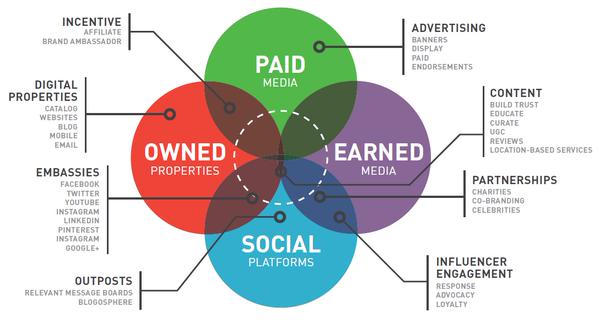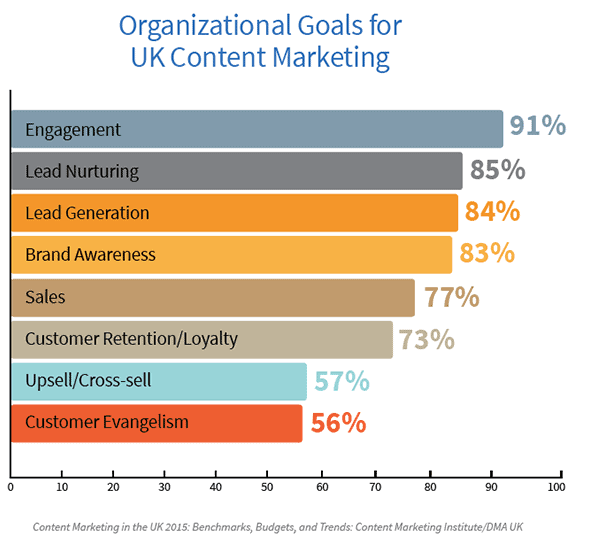When more than 80% B2B businesses vouch for content marketing, you must think, what does it actually do? Why is there so much hype about content marketing, especially on the Internet? One of my clients recently said that the only businesses making money out of this content marketing hoopla is the people who provide content marketing. It is just like the Gold Rush – the people who got rich were the ones who were selling the tools to the people who were rushing to find the gold.
They get content marketing all wrong. It is a process, it is not a campaign. As it is rightly said, it is a strategy. It is the way you promote your business in contemporary times when your prospective customer or client is constantly being bombarded by thousands of messages. And this problem is not just on the Internet, even on television there is so much content that it often becomes very difficult for quality content to be noticed.
Besides, people have developed this tendency to ignore advertisements. Content marketing gives you an opportunity to provide value to your prospective customers and clients without imposing on them.
Before doing business with you, people want to get to know you. They don’t want to see advertisements. It doesn’t make sense to hold casual conversations with them because they are never going to get comfortable on a personal level, unless, again, they know you properly. So what do you do? You create and publish content they are attracted to.
You see, content is everywhere. On the Internet, when people are not accessing their email (which is also in a sense content, but let’s ignore that) they are accessing content. They visit news websites. They watch YouTube videos. They check social media updates. They seek information about products and services. They read blogs and articles. Whatever they do, they are accessing content.
Nobody is forcing them to access that content. Nobody wakes them up in the morning and forces them to log onto the Internet and check their Facebook and Twitter updates. Nobody threatens them if they don’t check your blog. They do it on their own. That, is the strength of content and if you can leverage it, you understand the power of content marketing.
Why are most people confused about content marketing?
This is understandable. They don’t see any sense in continuously coming up with new blog posts, articles, infographics and videos and post them and then share them on social media and then try to engage people. They would rather do business, and if they want to promote their business, there is advertising. They are hung up on conventional advertising methods.
The problem is perhaps with the expression “marketing” and whenever there is a mention of marketing, the reference to advertising automatically creeps in. Marketing means advertising in conventional sense and since content marketing doesn’t feel like conventional marketing where you launch a campaign and then you wait for orders and leads to pour in, things become a bit blurry.
Just imagine from the perspective of a person who doesn’t know anything about content marketing. All he or she knows is people are writing detailed blog posts and articles and publishing them. What exactly are these publishers trying to achieve? This is something that needs to be explained. I mean, if I’m writing this blog post, what exactly am I trying to achieve? This is a Sunday afternoon. Wouldn’t I rather be enjoying myself or reading a book or something? If nothing, just sit in the sun? What are people trying to achieve when they are publishing content, when they are creating it, when they are talking about it and when they are distributing it?
Have a look at the graphic that I have taken from this Content Marketing Institute blog post that talks about how engagement and leads take center stage in businesses using content marketing in the United Kingdom.
As you can see, most of the businesses using content marketing in the United Kingdom use it for
- Engagement
- Lead nurturing
- Lead generation
- Brand awareness
- Sales
- Customer retention/loyalty
- Upsell/cross-sell
- Customer evangelism
Yes, “sales” is there but it is one of the goals of content marketing. Yes, “lead generation” is also there but it is also one of the goals of content marketing. Major goals also include engagement, brand awareness, customer evangelism and lead nurturing.
Content marketing gives you a presence. You provide useful content to your audience and your audience begins to relate that content to you. The search engines get more content to index and rank. People on social media and social networking websites get more content to share and talk about. People get to know about your expertise. They know that you are a good communicator. They know that you have lots of knowledge with you and you are eagerly sharing that knowledge with your visitors.
Coming back to the blog post that I’m writing right now – whom would you rather work with if your business needs a content writer? Someone who simply tells you that he or she is a content writer and that’s it, or someone who continuously shares his knowledge and experiences and tries to engage you into a dialogue so that the confusion about content marketing is dissipated and you can make use of it in a more informed manner?
But how does your business actually generate more sales with content marketing?
These days people need to know their brands in order to be able to do business with them due to multiple reasons and one of the main reasons is, multiple businesses are selling the same sort of products and services. The same sort of smart phone you can get from any company but still people buy the iPhones even when there are far more superior phones available in the market? It’s the presence Apple has made. They have loyal customers. They have brand evangelists. There is a prestige value involved. People are actually proud to own an iPhone (even if in private they envy their friends who own other phones).
There were many circumstances that contributed towards Apple attaining the sort of influence it attained, but the same sort of influence can be attained through content marketing, and there are many companies already doing that. Thousands of people are constantly writing about how great almost all Apple products are. People claim from the rooftops that they are Apple evangelists. Thousands of blog posts are written almost every day, although in the case of Apple, many of these blog posts are voluntary, but that’s another issue. The main point is, you can find tons of content on the Internet about the iPhone even if you are not familiar with the name of the company. You stop anybody on the road who is in a position to purchase a smart phone and he or she knows about the iPhone. It’s not just advertising. It’s constant writing. It’s constant video production. It’s constant photography. It’s constant conversation on social media and social networking websites. If you want to find something about the iPhone on the Internet, there is no dearth of content available on it. Result: the company can make around $ 42 billion in just a single quarter.
But what about a small business?
There is just one Apple. No matter how many are there, you can count the major smartphone companies on your fingertips. But what about a small business facing competition from thousands of vendors? How does a small business generate sales with content marketing?
Small business content marketing achieves the following for you:
- Increase your presence on the Internet
- Encourage people to talk about you, your product, your service and your brand
- Establish yourself as an authority figure
- Improve your search engine rankings
- Become a regular part of the lives of your prospective customers and clients
- Give people a reason to subscribe to your newsletter
- Educate your prospective customers about how your products and services can benefit them
- Bridge the gap between your business and your customers and clients by regularly engaging them
- Provide something valuable to your prospective customers and clients without expecting anything in return
- Create a vibrant and engaging presence on social media and social networking websites
An often-neglected advantage that a small business has is that it can strike a personal rapport with its prospective customers and clients which is difficult for a bigger company to achieve. You can write or produce much-focused content specially catering to your target audience.



